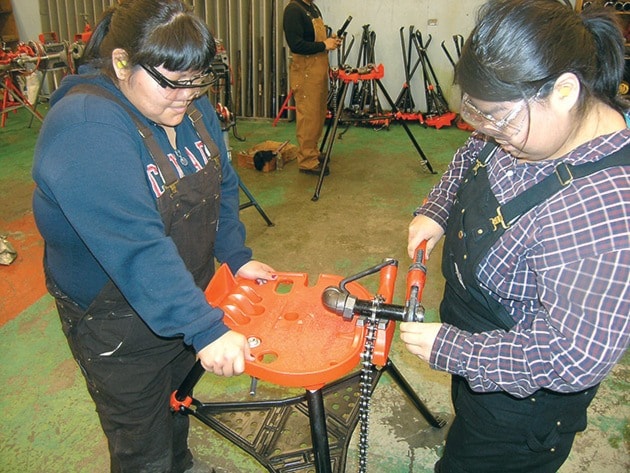It may look closed from the outside but Thornhill Junior Secondary School, which was shuttered several years ago as a result of a declining student population, is now the home to a private training college.
With a campus first in Kitimat and one now in Thornhill just outside Terrace, the UA Piping Industry College of B.C. runs specific classes and courses aimed at preparing participants for the early stages of careers in plumbing, sprinkler-fitting, steamfitting and welding.
Terrace-based coordinators Carolyn Barkman and Randy Chalifoux say the common area, two classrooms, meeting room and shop space being rented at the former junior secondary school are well-suited to the college’s needs.
“We rented temporarily at first and a year-and-a-half later, we’re still here,” explains Chalifoux. “We can talk about what to do in the class in the morning and actually do it hands on in the afternoon in the shop.”
The college was started 25 years ago by piping industry unions as a way of training people for careers in those skilled trades.
“There’s an expectation of a shortage of skilled employees and in the north and in B.C.,” says Chalifoux. “Here, there’s the opportunity to get people trained in the first level of apprenticeship.”
It also has a satellite campus in Kitimat for similar training and an added advantage is having the space for the college’s union sponsors to hold training programs when and as needed for their members employed on the several industrial projects underway in that community.
“Let’s say a union needs to hold a safety course. They can do it there,” says Chalifoux.

In Thornhill the college offers upgrading so, for instance, participants first improve their math skills, an essential requirement for trades employment.
It also offers a wide-ranging introduction to trades construction program and a foundation program tied to a specific trade.
Participants also receive life skills coaching and tips on preparation for employment.
Employment preparation takes in sessions on conflict resolution, group learning and safety.
“You may not like the guy on the other end of the pipe, but you need to learn how to work with him,” notes Chalifoux.
Instructors are brought in as and when needed depending upon the specific type of training program underway.
The great majority of program participants are First Nations from surrounding communities which, in the current housing shortage climate in Terrace and Thornhill presents a challenge, says Chalifoux. The New Aiyansh village government in the Nass Valley found a solution to the housing problem by renting a house in which 12 students from the village live, he adds.
The college does provide basic financial assistance – bus passes, for example, work boots and safety gear.
But participants also benefit from other agencies who provide living allowances and other assistance for the duration of their time with the college.
Aside from its presence in Thornhill and in Kitimat, the UA Piping Industry College has had a branch campus in Fort St. John, complete with a fully equipped welding facility for the past 10 years.
Its main campus is on Annacis Island in Delta in the Lower Mainland, a 70,000 square foot facility of 10 classrooms.
A crucial partner of the UA Piping Industry College of B.C. is the Industry Training Authority (ITA), the provincial agency which not only sets and maintains standards, qualifications and certifications for trades training but also provides those undergoing training with financial assistance.
“They’ve been very progressive at looking at the requirements for the piping industry and are doing an excellent job,” says ITA chief executive officer Gary Herman. “What they do is look at where the opportunities are for the trades they teach.”
Herman said the UA Piping Industry College of B.C. is one of 14 public institutions and 29 private training colleges connected to the training authority.
By being focused on specific trades, the training college can efficiently move in equipment and instructors when a demand exists, said Herman.
And having the college set up facilities in more remote areas increases the opportunities for local residents to begin training for new careers, he said.
